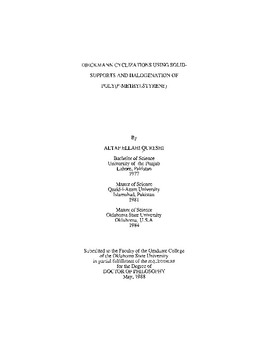| dc.contributor.advisor | Ford, Warren T. | |
| dc.contributor.author | Qureshi, Altaf Ellahi | |
| dc.date.accessioned | 2015-11-09T22:23:40Z | |
| dc.date.available | 2015-11-09T22:23:40Z | |
| dc.date.issued | 1988-05 | |
| dc.identifier.uri | https://hdl.handle.net/11244/21292 | |
| dc.description.abstract | Dieckmann cyclization is one of the most successful methods for the formation of compounds which contain rings of carbon atoms. Dieckmann discovered this process in 1894 and used it for the preparation of compounds containing five and six carbon atoms in a ring. The purpose of the present work was to prepare rings containing five and fifteen carbon atoms through Dieckmann cyclization of non-ring compounds having two different reactive groups at the ends (known as unsymmetrical diesters). The cyclization reactions were carried out in solution as well as inside swollen polystyrene (plastic) supports where one end of the diester was bound to the support. The yields were good using much higher concentrations of reactants than reported in the literature. The Dieckmann cyclization of unsymmetrical diesters can result in two products, but previously only one had been obtained. Both have been observed in this research, and 81% of the product that had never been observed before was obtained from one reaction. The attempts at Dieckmann cyclization of unsymmetrical diesters to form rings of fifteen carbon atoms failed in solution as well as on the polymer supports because the esters reacted in a different way. Although the cyclization reactions in solutions worked at 25 degrees C, the cyclization reactions of polymer supported esters were effective only at temperatures higher than 100 degrees C, because the chemical compound used to effect cyclization could not penetrate the swollen plastic at lower temperature. | |
| dc.description.abstract | Polymers constructed of networks of long carbon chains and having reactive chemical groups attached to them are important for the preparation of polymeric reagents and catalysts. An inexpensive, safe, new method to prepare such polymers was developed in our laboratory. The substitution of a hydrogen atom of a close relative of polystyrene with a chlorine or bromine atom was carried out with commercial laundry bleach. Sometimes the reaction was aided by a catalyst which disperses the bleach into both water and oily organic solvents. The extent of substitution of chlorine or bromine in the polymer was determined by analyses using infrared light and using radio waves in a magnetic field. | |
| dc.format | application/pdf | |
| dc.language | en_US | |
| dc.rights | Copyright is held by the author who has granted the Oklahoma State University Library the non-exclusive right to share this material in its institutional repository. Contact Digital Library Services at lib-dls@okstate.edu or 405-744-9161 for the permission policy on the use, reproduction or distribution of this material. | |
| dc.title | Dieckmann cyclizations using solid-supports and halogenation of poly(p-methylstyrene) | |
| dc.contributor.committeeMember | Berlin, K. D. | |
| dc.contributor.committeeMember | Purdie, Neil | |
| dc.contributor.committeeMember | Nelson, Eldon | |
| osu.filename | Thesis-1988D-Q9d.pdf | |
| osu.accesstype | Open Access | |
| dc.type.genre | Dissertation | |
| dc.type.material | Text | |
| thesis.degree.discipline | Chemistry | |
| thesis.degree.grantor | Oklahoma State University | |
